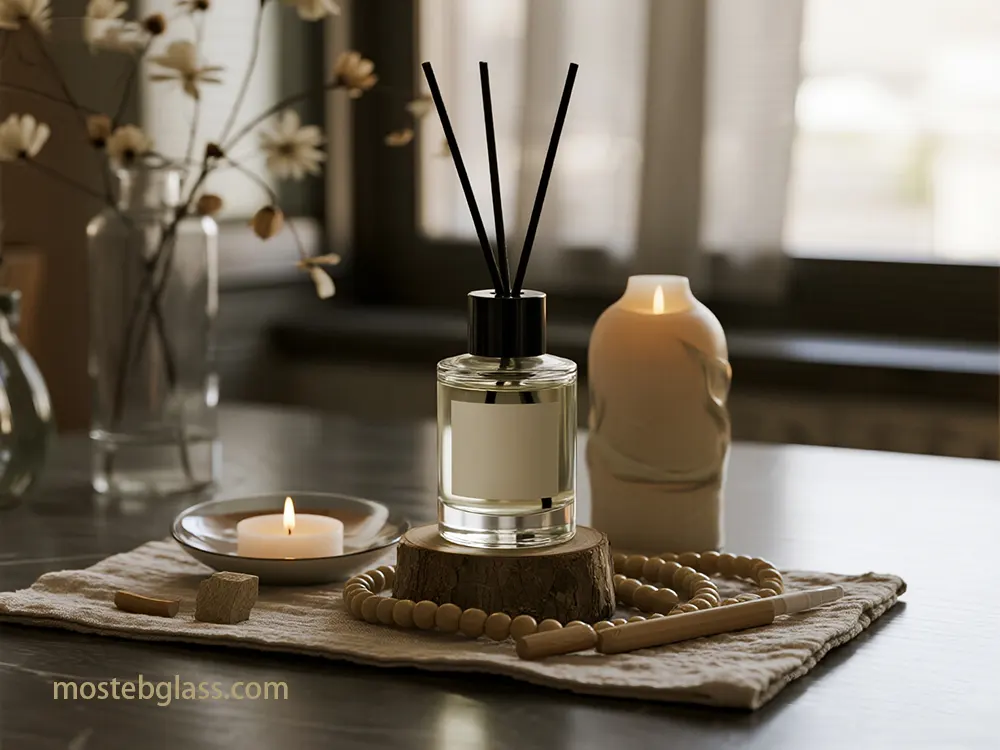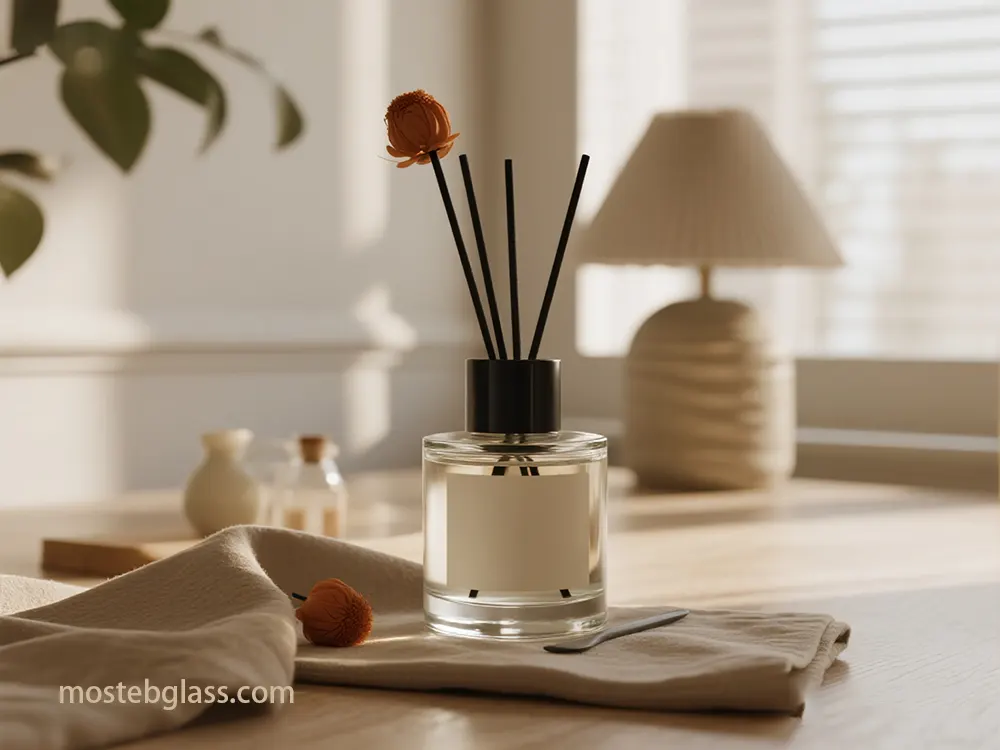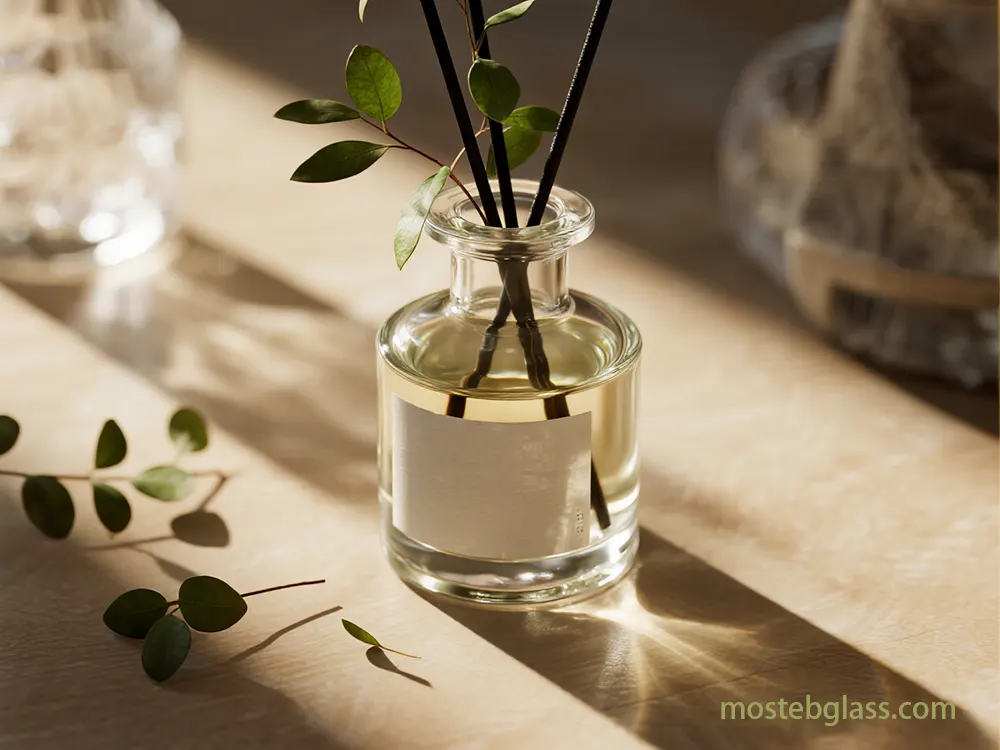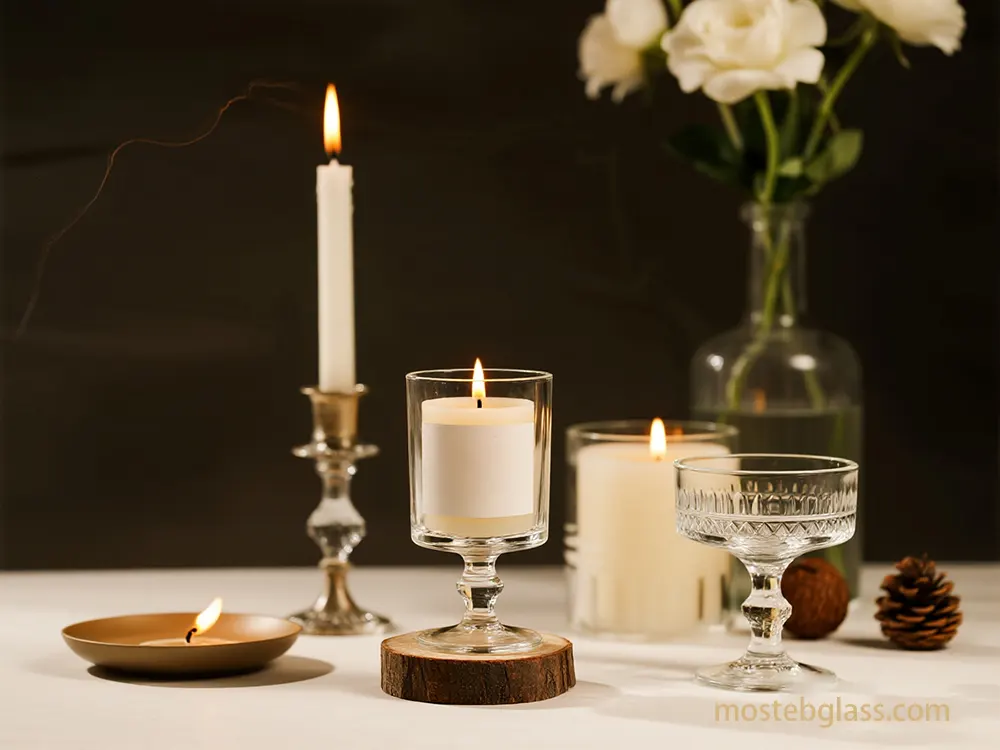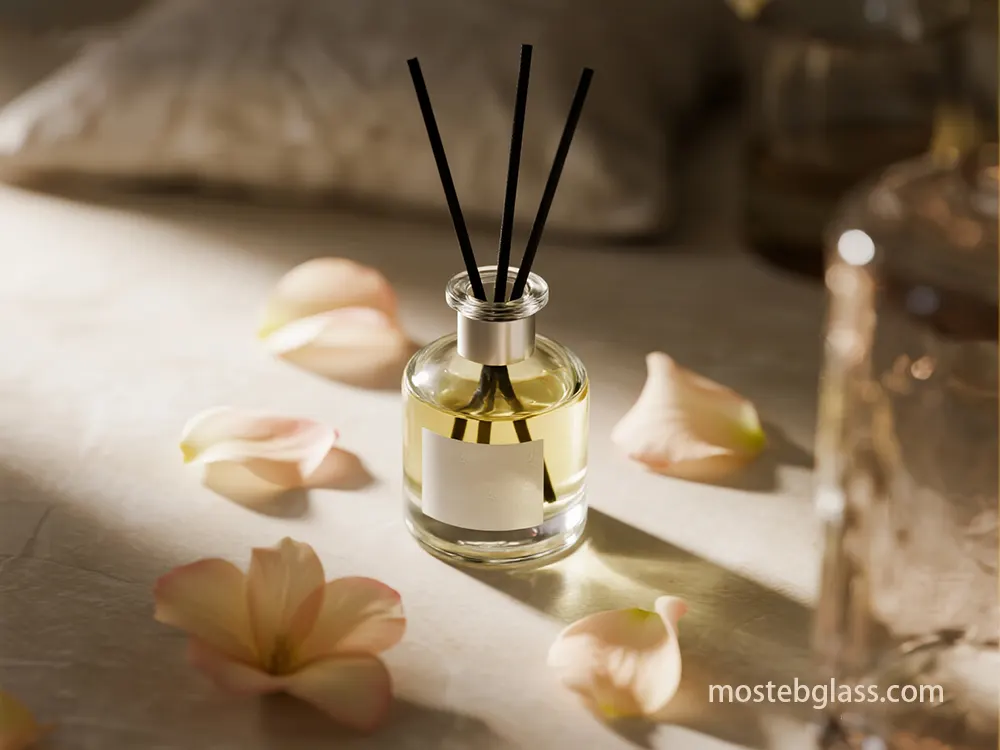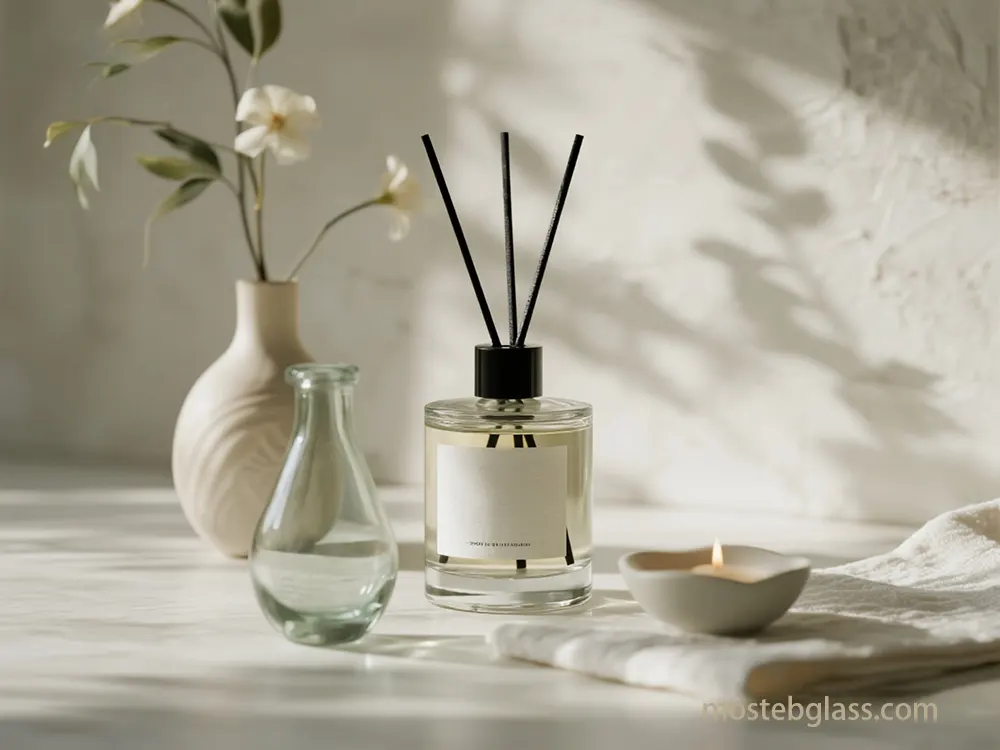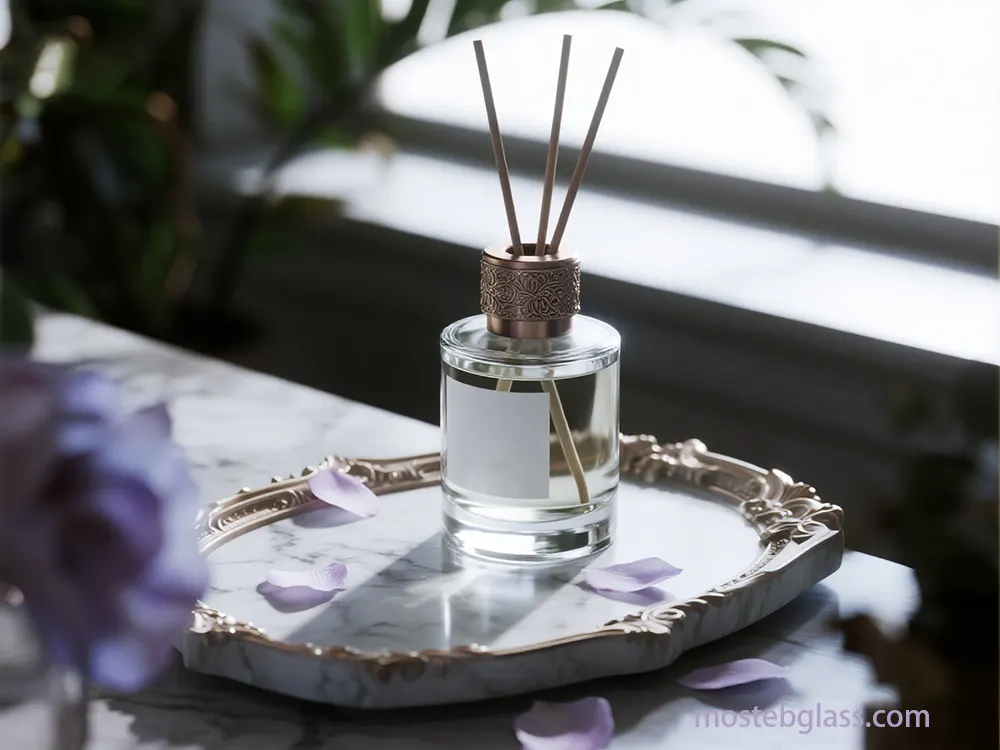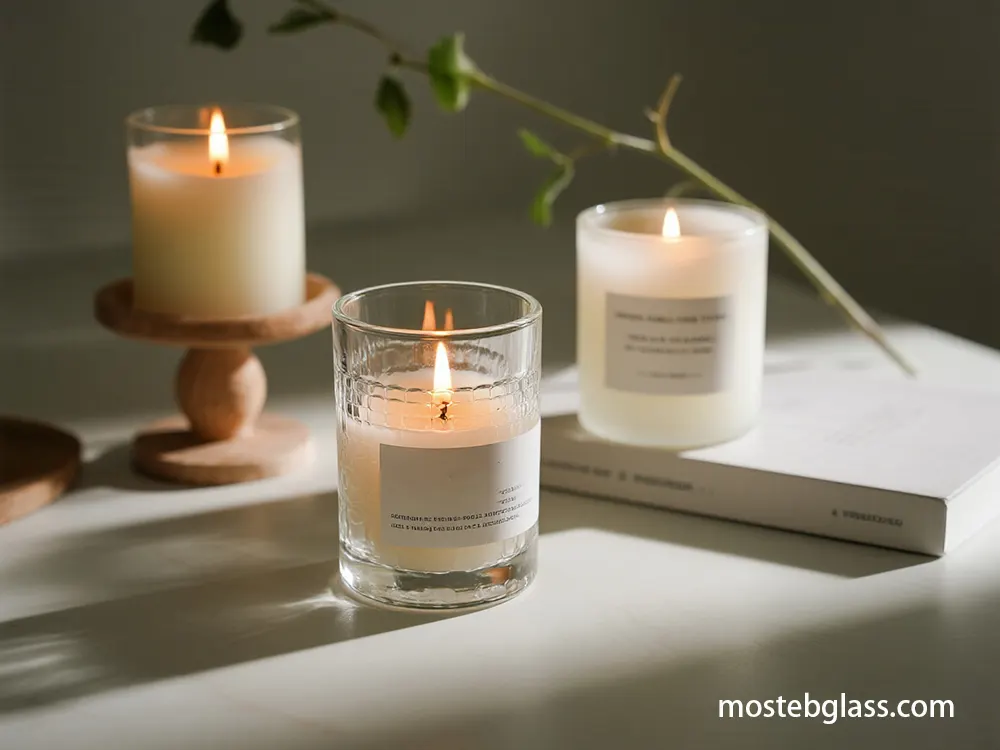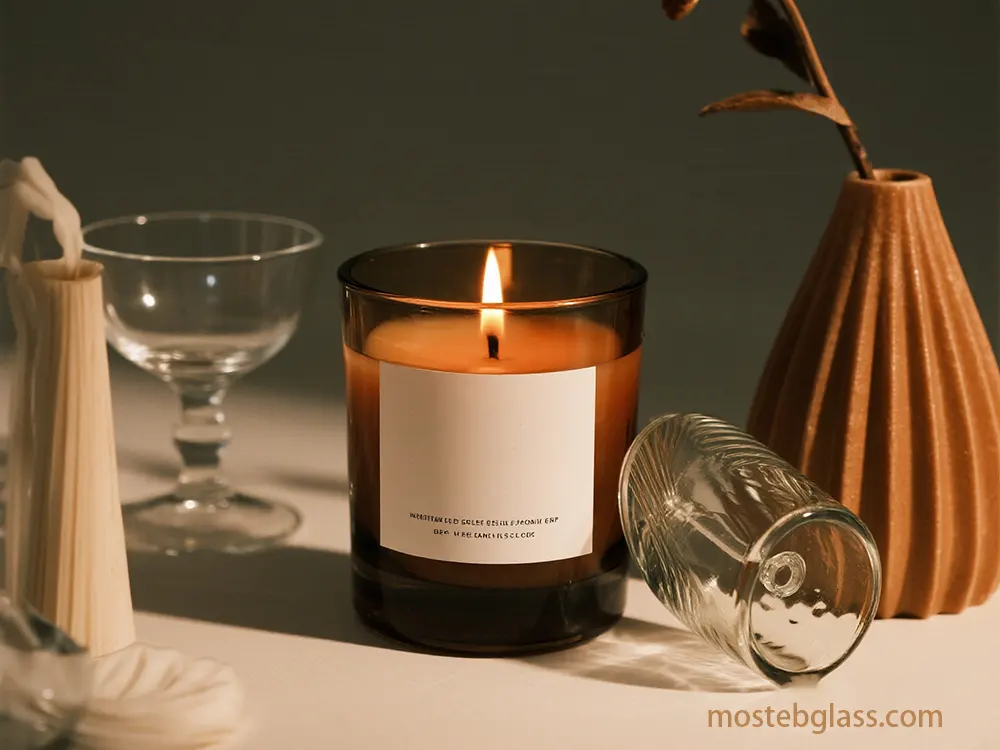1. Короткий виклад
Mosteb will initially focus on North American and European luxury markets, which will monitor the Asia Pacific for future expansion.
2.3. Effect of social media and technology
Social media is important for luxury marketing, emphasizing visual appeals and experienced content. Brands take advantage of it for sharing experiences and user-related materials, with packaging becoming self-material. The design in the AR/VR includes customers, and the QR code provides special materials. MOSTEB will integrate these digital strategies, which ensure the “Instagram” jar with smart packaging features.
3. Customization and Design Specifications
Mosteb’s custom glass candle jars will stand out through unique aesthetic and functional specifications, leveraging advanced manufacturing techniques and a strong commitment to sustainability.
- 3.1. Unique Shapes and Advanced Forming Techniques Beyond standard forms, Mosteb will explore distinctive geometric (e.g., hexagonal, faceted) and organic, irregular shapes.
- Advanced Glass Forming: CNC Glass Machining:
- Allows high-precision complex, organic, or geometric shapes, offering unparalleled design freedom despite higher costs. Waterjet Cutting:
- Offers intricate glass shaping precision. Hand-Blown Glass:
- Provides artisanal, one-of-a-kind pieces, ideal for limited-edition luxury lines. Containerless Processing:
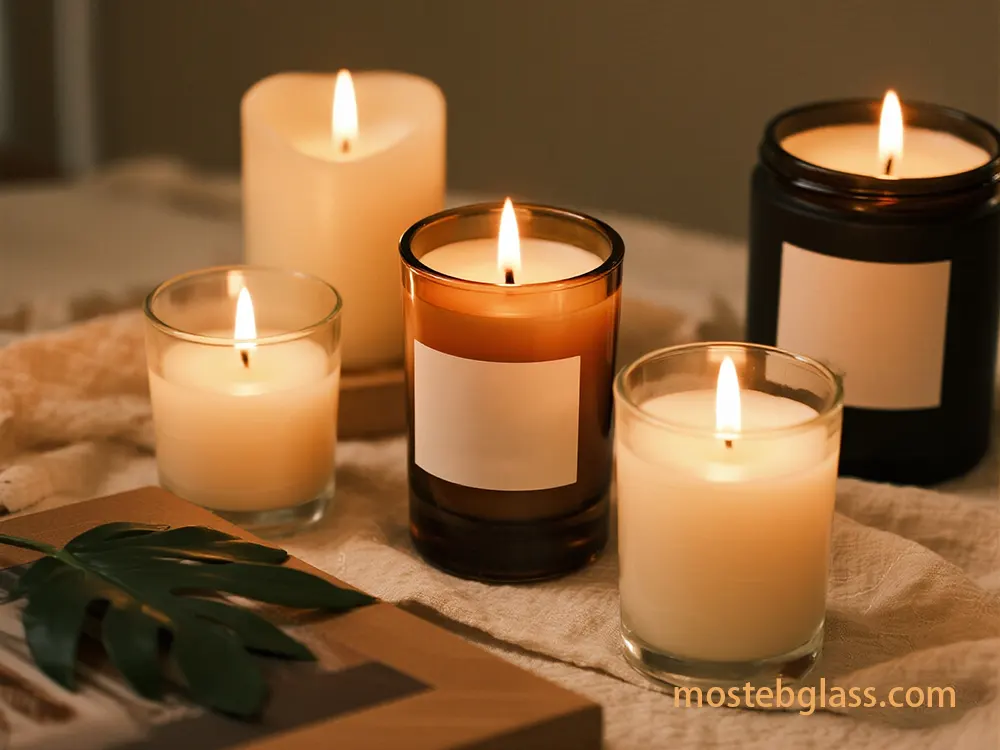
A cutting-edge technique, suspends material to produce high-purity glass without contamination, reducing nucleation risk and potentially yielding novel forms.
Virtual Twin Technology:
- Північна Америка: 3.2. Specific Colors, Finishes, and Surface Textures
- The visual and tactile experience of the jar is paramount for luxury positioning. Color and Transparency:
- Європа: Surface Textures:
Mixed Textures:
Like combining smooth glass with rope wraps, create unique tactile experiences.
Opaque Crackled Patterns:
From paint coatings, create unique artisanal designs.
Geometric Patterns:
Can be applied with stencils or tape using metallic/bold-colored paint.
Ombre Effect:
- Gradual color transitions via specialized painting.
- Metallic Accents: (gold, silver, rose gold, bronze) are applied via electroplating for opulence.
- Frosted Glass: Offers a modern, clean aesthetic and hides candle imperfections.
- Embossed or Textured Glass: (e.g., circles, dots, miniature windows) provides a luxurious appearance.
- Matte Finishes: Are sought for sophisticated elegance.
- Branding Integration: Custom logo printing, embossing, and hot stamping will seamlessly integrate client branding.
3.3. Carry type and closed mechanism
Lids are integral parts of both aesthetics and functionality, preserce the aroma and protect the candle.
- Material variety: Akshay, durable, often with silicon gasket for tight seals; Provides natural, environmentally friendly beauty.
- Cork:
- Biodegradable, durable, without damaging trees, adds rustic touch. Wood (pine, oak, walnuts, acacia):
- Continuous sour, natural beauty, variation in grain/color can be done, painted or branded. Mermal alloys (zinc, iron, tin):
- Effective in durable, sealing fragrance, available in brush/polish finish.Electroplating receives gold, silver or black color. protects the wax/fragrance; Some designs double as the base of a candle, often handcuffed to match.
- Smooth, modern forms, especially with frozen sedan jars. Recycled plastic:
- Less common for luxury, but can turn the waste into new lid components. Closure Mechanism:
- Tight seal, often with gaskets or silicon fitments, fragrance protection and dust protection are important for. Mostb safe, preference aesthetics. Multi purpose functionality:
- multi -purpose lids (eg, coaster, storage) value and align with stability. 3.4. Material specification and stability idea
- Mostb is committed to permanent practices during its product life cycle. Glass composition:
- Using quails (recycled glass) reduces energy consumption and needs virgin materials. Glass purity is infinitely recycled without loss. High PCR Material:
Mostb will aim to the highest possible post-conjumer recycled (PCR) glass content, possible with 100% PCR (eg, Veliaria UK). Glass is important for high PCR integration without compromising better quality to the chemical structure.
Lightwecting:
- By reducing the jar weight, the use of material is reduced and transport emissions. Design is required to maintain rigidity, potentially the production line optimization. Liters, twin technology in developing strong glass.
- Бамбук: Mostb will adopt eco-design to reduce environmental impact from concept to life of life.
- Mostb will look for manufacturers with ISO 9001 (Quality) and ISO 14001 (Environment) Certificates. Domestic manufacturers will follow strict security standards such as ASTM F2179 and California proposals. 4. Manufacturing and supply chain strategy
- The manufacturing and supply chain strategy of the Mostb will balance the cost-effectiveness, quality, adaptation and geopolitical ideas, focusing on a hybrid approach. 4.1. Geographical location and timeline
- China: Gives competitive pricing and comprehensive adaptation with large automation capacity 84. The lead time is 20–45 days, but geopolitical risk and tariff should be considered.
- Кераміка: Domestic US Sourcing provides low lead time (1-2 weeks for quality/shipping after design approval) and simplified logistics 95. Adherence to US security standards (ASTM F1279, California proposal 65) is an important advantage.
- Легкі, довговічні та майже перероблювані, металеві банки (алюміній, олов'яне листо) надають сучасний, мінімалістичний або комерційний стиль, особливо для туристичних світилля або високих температурних точок через теплопровідність. Mostb will adopt a diverse sourcing strategy:
- Early prototypes and small batch: prioritize US/European manufacturers for rapid recurrence and cooperation, or Chinese manufacturer with low emocue and strong design support.
- Moderate production: Leverage installed Chinese manufacturers for cost efficiency and scale, managing lead time and logistics.
- Timeline: Target for 3-6 weeks for standard production after design approval, for quality/shipping for 1-2 weeks.
4.2. Logistics and geopolitical ideas
Shipping Glass:
- Glass jars are heavy and delicate, requiring careful packaging to prevent rupture. Flush packaging offers a custom box for minimal breakdown and increased stability. Mostb will ensure strong packaging protocols. Tariffs and Business Policies:
- Unstable economic climate and trade policies can cause shocks and delays of pricing. The US counterwalling law imposes special tariffs against subsidized imports. Mestabe should be a factor in a potential tariff, especially from China, and diverse suppliers (eg, Southeast Asia, Europe, Mexico) consider gaining diversity to reduce risks. Suppliers Vetting:
- The required veating criteria include production capabilities, communication accountability (Respent5H average response preferred), and moral/permanent supply chain platforms such as Sadex. 5. Cost Analysis and Budgetary Framework
- A wide understanding of cost drivers and adaptation strategies is important for the mostb to ensure financial viability and competitive pricing. 5.1. Estimated budget limit and target cost per unit
- 5. Risk Mitigation & Future-Proofing the Supply Chain 5.2. Key cost driver
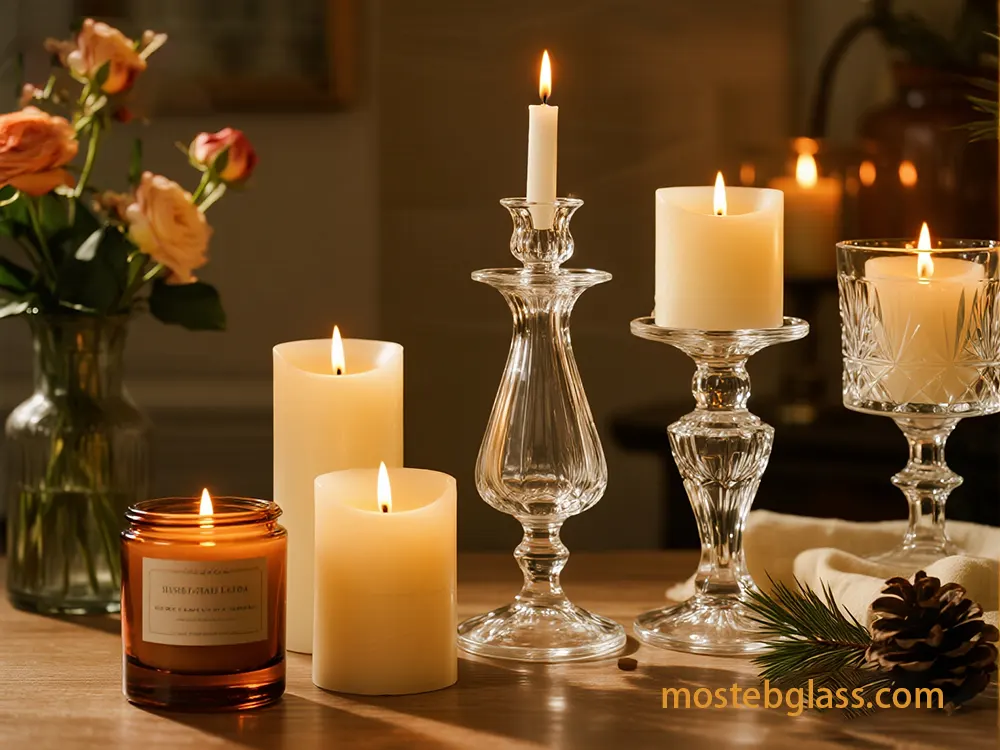
Several factors significantly impact overall cost:
Initial mold cost:
once engineering cost for design/construction. Soda-Lime Glass Mold can cost ~ $ 1,680 (~ $ 0.34/5,000 units ~ $ 0.34/unit).
- Glass content: Glass choice (soda-lame, borosilicate, crystal, tempered) significantly affects the cost. Primium content such as crystal white glass with low iron content (0.005%) provides better clarity but costs increase.
- Design complexity: Simple design (cylinders, shells) are more inexpensive; Complex shapes or textures increase mold and production costs.
- Європа: surface treatment such as spray paintings, silk screen printing, hot stamping, delicate application, and electroplating unit costs.
- Cip material:
- The choice of material (bamboo, glass, metal, cork, plastic) and adaptation (eg, branding) affect overall costs. Labor Cost:
- High labor cost locations may require more automation for profitability. Strict measures including secondary inspection, add costs but ensure high standards.
- Packaging: The cost of supply (stickers, labels, compartments) differ from value and quality, affecting overall pricing.
Size:
- Different jars affect pricing (eg, 4oz, 6oz, 8oz, 10oz, 12oz, 14oz, 16oz) pricing. 5.3. Cost Optimization Strategies
- Mostb can apply several strategies to optimize costs without compromising the quality: Design for manufacturing (DFM):
- DFM reduces the use of materials, simplifies manufacturing, and reduces costs. Volume discount interaction:
Strong suppliers reduce the relationship and bulk order discount cost.
The economy of the scale:
The amount of rising production reduces the cost per unit.
Efficient supply chain management:
reduces on-site production/assembly transport costs.
Strategic Material Selection:
- Choosing appropriate glass (eg, soda-lime for standard lines) reduces the cost of mold compared to premium content. Adjusting the level based on trends/demands maximizes sales and reduces additional stock/holding costs.
- Direct Sourcing: Eradicates unnecessary commissions/charges directly from experienced suppliers.
- 5.4. Implications of Mold Ownership There are important long -term implications for Mostb in the decision of mold ownership:
- Benefits of Ownership: Mold’s ownership gives complete control to Mostabs on production, quality and design rights. This prevents unauthorized replica and provides flexibility to promote suppliers, promoting competition.
- “Tulling Mortgage” landscape: Without clear ownership, manufacturers can catch the mold “hostage”, “demanding prices, extending the lead time, or refusing to release, produce supply chain weaknesses.
- Cost of “free” molds: Accepting “free” molds is a false economy; Factories recover costs and build profit in unit prices, which leads to high long -term costs.
- Контроль якості: Mostb should pay a dedicated, once a mold development fee. It establishes legal ownership and protects intellectual property.
- Constituent Agreement: Apparently defines mold ownership in contracts, specifying “ownership” over “right to use”. A “exclusive rights of use” usually holds the mold in the factory, preventing suppliers changes.
- Tariff implications: The cost of bundling mold in the price of the unit can import duty on the devices of the mostb. Helps protect the cost of mold separately.
Budget for Mostb:
Mostb will join the budgetary structure:
- One -time tooling cost (mold ownership). Per-unit production cost (material, manufacturing, labor, QC).
- Cost of decoration (surface treatment, printing). Cost cost (material, finish, adaptation).
- Packaging cost (internal/external). Logistics and shipping (goods, duty, tariff).
- Quality assurance and test (heat resistance, leak). Contingency (unexpected cost).
- 6. Recommendations and implementation roadmap Based on comprehensive analysis, the Mostab has been well deployed to enter the Custom Glass Candle Jar market by focusing on innovation, stability and strategic partnership.
- Factories should have a clear ability planning functioning to understand realistic work handling and timeframe. This careful plan ensures smooth, uninterrupted production flow and prevents bottlenecks. The luxury candle market is strong, inspired by the demand for durable, personal and beauty products.
- Advanced Glass Forming (CNC, hand-blowing, containerless, virtual twin) offers unique design opportunities. Various permanent lids increase the appeal (bamboo, cork, wood, recycled metal) and finish appeal.
A hybrid manufacturing strategy (domestic/international) optimizes cost, quality and lead time.
The clear mold ownership protects the IP and ensures the supply chain flexibility.
- Stability, especially high PCR materials and lightweight, expect a significant discrimination and consumer. 6.2. Actionable steps and implementation roadmap
- Here is a phased roadmap for the Mostb to bring the Custom Glass Candle Jar ready for its market for production: Step 1: Design and prototypeing
- Serve the design specifications: Size and texture:
- Develop 3-5 separate jar design (geometric, texture, minimum). Use virtual twin techniques for rapid recurrence/simulation. Color and finish palette:
- Define core palette (eg, matte black, frosted white, metallic gold, natural wooden grains for lids). LID Integration:
- Design beauty/functionally complementary lids, prioritizing durable material (bamboo, cork, wood) with safe gaskets. Branding:
Integrate the branding of the mostab (laser engraving on the laser, subtle embossing on the jar base).
Material selection and stability target:
- Specify glass composition, target minimum 50% PCR, long -term 100% PCR for specific lines.
- Define lightweight goals per design, ensuring structural integrity through adaptation.
- Early manufacturer engagement:
- Identify 3-5 potential manufacturers (eg, Glasswow for US Artisan, Chinese Custom/Buyusino/DM Glassware for Low MOQ).
- Request initial quotes for shared design, mold development and unit pricing (10K, 25k, 50k units).
- Priority to manufacturers with strong DFM, permanent practices and certificates (ISO 9001, ISO 14001).
- Mold development and sample production:
- Select the primary manufacturer for expertise, cost, lead time basis for mold development.

Importantly, the interaction and pay for the ownership of the mold, ensure clear constructive conditions for complete legal ownership and the right to transfer the mold.
Overseas sample production (~ 35 days).
Conduct rigorous safety test (heat resistance, leak) on samples with wax/vic combinations of the mostb.
- Step 2: Production and supply chain setup
- Final the manufacturer contracts:
- Depending on sample quality/cost, finalize contracts with 1-2 primary manufacturers for initial production.
- Establish clear words for quality control, lead time, payment and IP protection.
- Order Placement and Production Monitoring:
- Give initial order, balance the cost efficiency with market demand (eg, 10,000-25,000 units per sku).
To monitor the production and ensure specifications, apply strong quality assurance, including inspection on the site.
Logistics and Packaging Strategy:
Develop detailed logistics scheme (insurance for shipping route, carrier, delicate glass).
- Design custom to reduce breakdown and environmental effects, environmentally friendly packaging (eg, flush packaging).
- Causes in potential tariffs/geo -political risks, maintaining sourcing flexibility. Inventory Management System:
- Set an inventory system to track stocks, manage re -order points and optimize storage for various jar sizes. Step 3: Market launch and continuous improvement
- Marketing and sales integration: Develop visually attractive social media materials, highly design, stability and privatization.
- Integrate smart packaging (eg, QR code) for increased consumer engagement/traceability. Response Loop and Repetition:
- Collect customer feedback on design, quality and stability.
- Evaluate continuous manufacturing processes and suppliers performance.
- Explore new techniques (eg, 3D glass printing 38) and materials to stay further.
- Extension and Diversification:
- Scale production increases with existing partners or onboard new manufacturers.
- Explore new market segments or regional expansion based on analysis.
- 6.3. Active solution and future ideas
- Circular Economy Model:
- Explore a closed-loop system for jar returns (cleaning, refilling, recycling in new products), potentially partnership with local recycling or direct mail-back programs.
- Advanced content research:
- Check novel glass yogas for increased durability, light weight, or unique aesthetics (eg, self-cleaning surfaces, temperature-reactive coatings).
- AI-Pied Design Adaptation:
Use AI for generative design, the discovery of thousands of jar shapes/textures, fulfilling beauty, functional and manufacturing barriers, potentially highlight novel designs.
- Blockchain for supply chain transparency:
- Applying blockchain to track raw materials (PCR material), manufacturing and moral labor, provides unique transparency to luxury consumers.
- Strategic Alliances:
- Consider collaborations with renowned designers, artists, or luxury brands for limited-edition collections, enhancing Mosteb’s brand prestige and market reach.
- By meticulously executing this roadmap and embracing continuous innovation, Mosteb can establish itself as a leader in the custom glass candle jar market, delivering exceptional quality, design, and sustainability to its discerning clientele.
- Wholesale Candle Jars
- Wholesale Diffuser Bottles
- Wholesale Glass Vases
- Latest Insights
- Case Study: Overcoming Challenges in Large Glass Diffuser Bottles Manufacturing
- Custom Glass Christmas Ornaments – Driving Brand Differentiation in Seasonal Markets
- Customization in Glass Ornaments: Unlocking Opportunities for Differentiated Branding
Case Study: Custom Glass Unique Diffuser Bottles Manufacturing for a Spain Brand
- Large Diffuser Bottles: Redefining Luxury Home Fragrance Packaging
- Sustainability in Glass Flower Vase Manufacturing: Global Market Trends
- Case Study: Custom Irregular-Shaped Tall Glass Candle Holders for a Belgian Client
- Comment
- Submit your opinion
- get a free quote
- Complete our quote request form or email us at
- to receive a customized quote from our product specialists.
- Company
- Phone/Whatsapp
Select a product
- glass candle jars Reed Diffuser Bottle
- glass vases Quantity
- contact our Product Expert Send us a message freely if you have any questions. We’ll get back to you within 30 minutes via email at
- , and we’ll adhere to the privacy policy to protect your information. full name
- email adress Please provide us with the capacity, shape, color, and quantity of the glass containers you require. Alsoplease feel free to share any other details or specific requirements to help us better understand yourproject.
Tell us your requirements, such as capacity, quantity, customization, etc.




